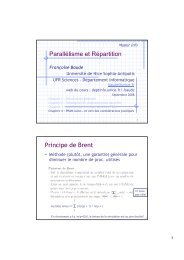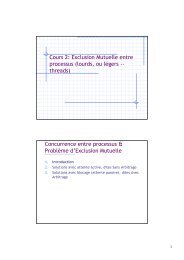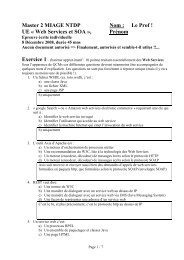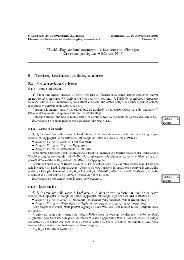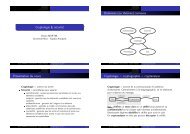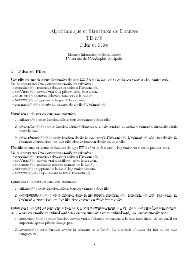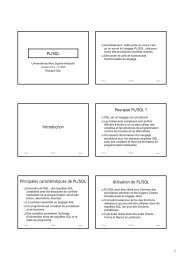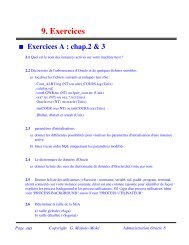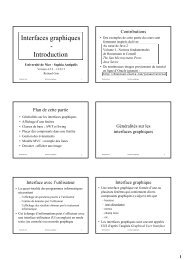TikZ and pgf
TikZ and pgf
TikZ and pgf
Create successful ePaper yourself
Turn your PDF publications into a flip-book with our unique Google optimized e-Paper software.
\begin{tikzpicture}[scale=3,cap=round]<br />
% Local definitions<br />
\def\costhirty{0.8660256}<br />
% Colors<br />
\colorlet{anglecolor}{green!50!black}<br />
\colorlet{sincolor}{red}<br />
\colorlet{tancolor}{orange!80!black}<br />
\colorlet{coscolor}{blue}<br />
% Styles<br />
\tikzstyle{axes}=[]<br />
\tikzstyle{important line}=[very thick]<br />
\tikzstyle{information text}=[rounded corners,fill=red!10,inner sep=1ex]<br />
% The graphic<br />
\draw[style=help lines,step=0.5cm] (-1.4,-1.4) grid (1.4,1.4);<br />
\draw (0,0) circle (1cm);<br />
\begin{scope}[style=axes]<br />
\draw[->] (-1.5,0) -- (1.5,0) node[right] {$x$} coordinate(x axis);<br />
\draw[->] (0,-1.5) -- (0,1.5) node[above] {$y$} coordinate(y axis);<br />
\foreach \x/\xtext in {-1, -.5/-\frac{1}{2}, 1}<br />
\draw[xshift=\x cm] (0pt,1pt) -- (0pt,-1pt) node[below,fill=white] {$\xtext$};<br />
\foreach \y/\ytext in {-1, -.5/-\frac{1}{2}, .5/\frac{1}{2}, 1}<br />
\draw[yshift=\y cm] (1pt,0pt) -- (-1pt,0pt) node[left,fill=white] {$\ytext$};<br />
\end{scope}<br />
\filldraw[fill=green!20,draw=anglecolor] (0,0) -- (3mm,0pt) arc(0:30:3mm);<br />
\draw (15:2mm) node[anglecolor] {$\alpha$};<br />
\draw[style=important line,sincolor]<br />
(30:1cm) -- node[left=1pt,fill=white] {$\sin \alpha$} (30:1cm |- x axis);<br />
\draw[style=important line,coscolor]<br />
(30:1cm |- x axis) -- node[below=2pt,fill=white] {$\cos \alpha$} (0,0);<br />
\draw[style=important line,tancolor] (1,0) -- node[right=1pt,fill=white] {<br />
$\displaystyle \tan \alpha \color{black}=<br />
\frac{{\color{sincolor}\sin \alpha}}{\color{coscolor}\cos \alpha}$}<br />
(intersection of 0,0--30:1cm <strong>and</strong> 1,0--1,1) coordinate (t);<br />
\draw (0,0) -- (t);<br />
\draw[xshift=1.85cm]<br />
node[right,text width=6cm,style=information text]<br />
{<br />
The {\color{anglecolor} angle $\alpha$} is $30^\circ$ in the<br />
example ($\pi/6$ in radians). The {\color{sincolor}sine of<br />
$\alpha$}, which is the height of the red line, is<br />
\[<br />
{\color{sincolor} \sin \alpha} = 1/2.<br />
\]<br />
By the Theorem of Pythagoras ...<br />
};<br />
\end{tikzpicture}<br />
3.21 Nodes<br />
Placing text at a given position is just a special case of a more general underlying mechanism. When you<br />
say \draw (0,0) node{text};, what actually happens is that a rectangular node, anchored at its center, is<br />
put at position (0, 0). On top of the rectangular node the text text is drawn. Since no action is specified for<br />
the rectangle (like draw or fill), the rectangle is actually discarded <strong>and</strong> only the text is shown. However,<br />
by adding fill or draw, we can make the underlying shape visible. Furthermore, we can change the shape<br />
using for example shape=circle or just circle. If we include the package <strong>pgf</strong>libraryshapes we also get<br />
ellipse:<br />
36






